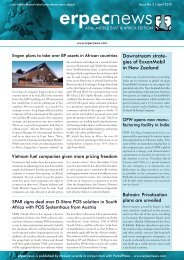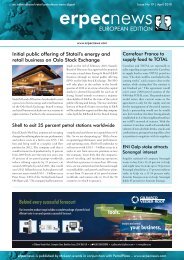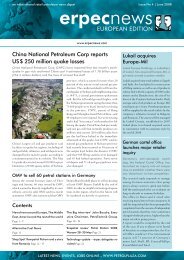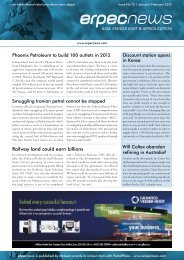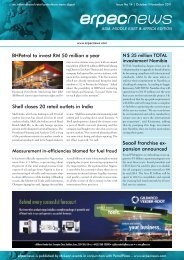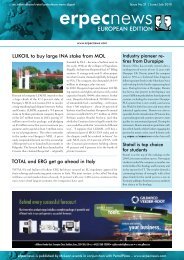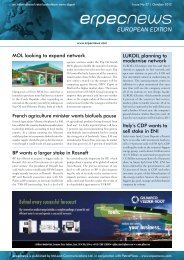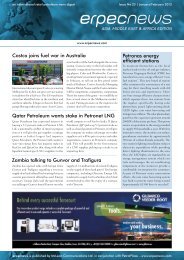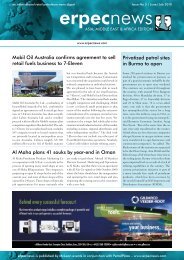Tanzania Oil companies want fuel testing Galp wants ... - ErpecNews
Tanzania Oil companies want fuel testing Galp wants ... - ErpecNews
Tanzania Oil companies want fuel testing Galp wants ... - ErpecNews
You also want an ePaper? Increase the reach of your titles
YUMPU automatically turns print PDFs into web optimized ePapers that Google loves.
lighting<br />
followed in 1870, invented by Thomas Edison.<br />
Gas discharge arrived in 1920 i.e. fluorescent<br />
tubes and neon lighting and another 40 years<br />
later in 1960, General Electric discovered Light<br />
Emitting Diode technology, LED. An electrical<br />
reaction occurring when a negative electron<br />
particle enters a positive one. This releases<br />
a photon that in turn gives off instantaneous<br />
light. To be exact, the strict definition of LED<br />
is a diode/semi-conductor converting electrical<br />
current into light or sometimes more simply<br />
put, a digital light”.<br />
I asked Remko why he opted for this ‘almost<br />
introductory’ approach. He countered “My<br />
presentation attempted to answer a few very<br />
simple questions which I think many customers<br />
still have. LED is taking over the world at a<br />
very rapid rate and its fairly difficult for people<br />
to get a grasp on what exactly the LED market<br />
is all about. So for my talk I first worked out<br />
five basic questions. What’s LED? How much<br />
light does an LED give? Where can the biggest<br />
savings be found? What makes or breaks an<br />
LED luminaire? What will the future bring?”<br />
For the uneducated amongst us I had to ask<br />
Remko what a luminaire was and he pointed<br />
out that it is a big flood light, like those used<br />
on forecourt canopies or for perimeter lighting.<br />
The simplistic angle to his presentation<br />
surely paid off when several delegates I spoke<br />
to said that these questions were exactly the<br />
type they were becoming too embarrassed to<br />
ask, proving his point totally.<br />
I asked Remko to talk freely about the benefits<br />
of LED from his perspective and to illustrate<br />
the varying factors applicable to LED in different<br />
parts of the world. Having travelled most<br />
of it during the last few years, he digressed<br />
“The main quality of this lighting type is its<br />
durability. A diode or a semi-conductor is very<br />
small and light so when it gets shaken around,<br />
nothing happens. Because of this it is virtually<br />
shock proof. Semi-conductors also have a very<br />
long life span.<br />
Being turned on and off very quickly is also<br />
a feature of LED, which does not harm it in<br />
any way, whereas a normal lamp would break<br />
much faster in these circumstances. In the life<br />
of a retail petroleum site, say in Asia where the<br />
power supply is unreliable, especially in the rainy<br />
season, surges of power are not conducive to a<br />
An interview with Remko Delfgaauw, CEO Bever Innovations by Nick Needs<br />
continuous lighting solution. When I was in<br />
India recently I did not see one petrol station<br />
with all its lights in operation at any time. I<br />
believe that LED technology is a great fit for this<br />
part of the world, just because it is so robust”.<br />
In Europe and the western world generally,<br />
where power grids are far more reliable, it is<br />
the cost of electricity that makes LED so attractive,<br />
particularly when prices are predicted<br />
to rise fast in the coming years. Remko told<br />
me that in Australia and South Africa, the<br />
dealers that he speaks to are coping with<br />
increased electricity costs of over 30 percent<br />
per year. I asked him how much of a saving<br />
a petrol station with LED lighting would<br />
make bearing in mind the initial investment<br />
required. He commented “The older metal<br />
halide lamps typically the 400 watt units used<br />
widely on petrol stations today, use 75 percent<br />
more electricity than LED lamps. On a site<br />
which has 18 – 20 such units, the energy savings<br />
would be extremely impressive. There is<br />
also the life span of a bulb to consider with the<br />
normal metalhalide variety lasting typically<br />
only 20 000 hours. The LED equivalent will<br />
last up to 5 times longer.”<br />
As mentioned earlier in this article, Bever<br />
operates only in the petrol station market. I<br />
asked Remko why this was so important to<br />
him. He says “It’s still the cornerstone of our<br />
company. You can’t compare us in size with<br />
the big lighting organisations which turn over<br />
billions of euros each year, but because we<br />
work only in the retail petroleum sector we<br />
know exactly what our customers <strong>want</strong>. For<br />
example our new remote control device like the<br />
one you might use with your television set, can<br />
manage and program our lamps individually<br />
just by pointing and clicking. The remote can<br />
even change the wattage of each lamp if there<br />
is a light imbalance of any sort to make sure<br />
that each part of the forecourt is illuminated<br />
evenly. This device has been developed purely<br />
with the petrol station in mind.<br />
The focus we have in the retail petroleum business<br />
allows us to constantly look for specialised<br />
solutions, not standard ones”. After studying<br />
all the Bever product listings, the one product<br />
feature which caught my eye was the facility<br />
with the Luci series for it to respond to<br />
traffic arriving on the forecourt. A sensor<br />
latest news, events, jobs online – www.PetrolPlaza.com<br />
FeATUre – Bever INNOvATIONs<br />
automatically ‘sees’ customers at the pumps<br />
and then switches lights from dimmed to full<br />
power, making direct energy and cost savings.<br />
Simple but extremely effective.<br />
Luci series intelligent lighting<br />
A remote control to easily change light settings from<br />
ground level<br />
I suggested to Remko that the colour of light<br />
produced by LED lamps has been an issue<br />
in the marketplace, being maybe too white<br />
and not yellow enough as supposedly <strong>want</strong>ed<br />
by some people. Is there any truth in this I<br />
asked? He said “These days, contrary to what<br />
people might think, we can produce LED light<br />
in any colour you <strong>want</strong>, whether it is for the<br />
shop, where a warmer yellow light might work<br />
better, or for outside on the forecourt, where<br />
a white bright LED lamp promotes a clean<br />
modern environment”.<br />
Looking in the Bever corporate brochure, a<br />
photograph of a huge Shell site in Luxembourg<br />
showed clearly the light differences between<br />
the inside and the outside of a petrol station.<br />
Remko told me that this was an exceptional<br />
project for them on one of the largest petrol<br />
sites in Europe, selling over 300 million litres<br />
of tax advantaged <strong>fuel</strong> per annum. Over 180<br />
17



